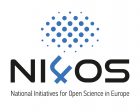This webinar presented tools and examples for building National Open Science Cloud Initiatives (NOSCIs) and highlighted their contribution and connection to the EOSC ecosystem.
A NOSCI is envisaged as a coalition of national organizations that have a prominent role and interest in the Europe Open Science Cloud (EOSC). The main aim of NOSCI will be the promotion of synergies at national level, and the optimization/articulation of their participation to European and global challenges in this field of OSC, including the EOSC. National initiatives are envisaged to play a prominent role in Member States and Associated Countries and facilitate EOSC governance.
The webinar was organized in the context of WP2 which supports the NI4OS- Europe mission to guide the development of NOSCIs in the region. WP2 is led by ATHENA Research and Innovation Center and engages as core contributors also GRNET and UOB IICT. All partners on the national level have dedicated effort in this WP to support set-up of NOSCIs, the related with governance issues and the National representatives in the EOSC governance board form the countries.

Ognjen Prnjat from GRNET welcomed everyone in the webinar and pointed out that the event provides an opportunity for partners to communicate with and learn from each other and thus it should be equally perceived as a project meeting. Next, Eleni Toli from ATHENA Research and Innovation Center also welcomed partners and expressed the scope of this meeting before introducing the speakers.
First set of presentations intended to set the background of WP2 work and inform about its outputs. Final presentations showed current NOSCI developments in the NI4OS-Europe countries and updated on the EOSC Association.
More specifically, Electra Sifakaki presented D2.2 “NI4OS-Europe National OSC initiatives models” as a tool for guiding NOSCI activities and noted that this is just the starting point with regards to WP2 support to partners undertaking relevant actions in their countries. Next, Ilias Papastamatiou and Elli Papadopoulou analyzed the three key elements of the Blueprint.
Workflows:
Showing pathways for NOSCIs formulation with a specific nature of operation, i.e. Top down (objective-driven) , Bottom up (data-driven) or Hybrid. Workflows reflect on strategic approaches undertaken by partners that operate in national partnerships in the form of task forces, consortia, national projects, professional associations or legal entities.
Indicators:
Proposing an indicative set of metrics that may be used for the assessment of the status and progress of the NOSCI in the region. The proposed indicators are in line with the EOSC Readiness Indicators and may be used as a guide to complement the establishment and operation of a NOSCI.
Operational aspects:
Delving into the practical aspects for establishing and operating a NOSCI, such as the governance which is needed for the partnership to function, but also key areas of work to be performed within this collaborative framework, such as developing a national strategy.

Following up, Eleni Toli provided Example Workflows from a practical point of view and analyzed how NOSCIs can work in real settings. Her presentation was based on feedback received from partners during WP2 interviews that took part in early 2021. Then, Ilias Papastamatiou highlighted the benefits of the EOSC Association for the research community and made the links with NOSCIs. The meeting ended with Christos Liatas who presented the Next Steps of work with NI4OS-Europe partners, including an Indicative timeline of deadlines.

In conclusion, the webinar aimed at highlighting the available tools and steps for creating national EOSC partnerships that liaise with the EOSC Governance and are integral parts of the EOSC Association. NOSCIs are especially important because they recognize socio economic diversity and Open Science maturity of countries, while their modelling brings up good examples per use case scenario. WP2 urges colleagues outside the NI4OS-Europe consortium to use its outputs to build NOSCIs in their countries and regions. NOSCIs rely on collaborations between stakeholders and are keen to expand know-how exchange at a global scale.
Useful Resources:
- D2.2 “NI4OS-Europe National OSC initiatives models”: https://zenodo.org/record/4061801#.YCKammgzY2y
- Webinar presentations and supporting material: https://training.ni4os.eu/course/view.php?id=59

Pingback: Towards the realization of national Open Science Cloud ecosystems in the Southeastern Europe (SEE) – NI4OS- Europe
Pingback: Na poti k uresničitvi nacionalnih ekosistemov za oblak odprte znanosti v jugovzhodni Evropi (JVE) - Skupnost odprte znanosti Slovenije
Pingback: Novice slovenske skupnost odprte znanosti | Odprta knjižnica